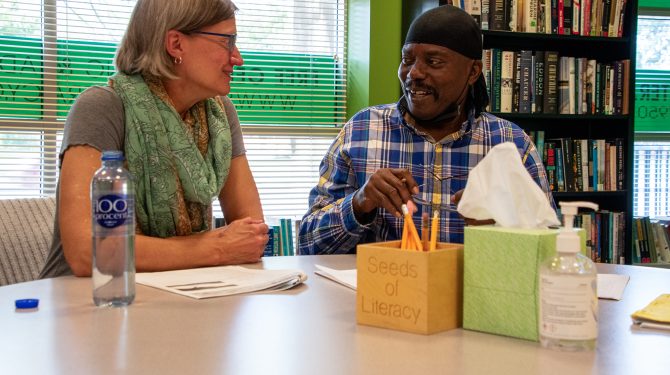4 Reasons Tutors Should Use Mindful Pauses

One of the best things a tutor can do for a student is allow them a quiet moment to mull over lessons and figure out problems. It’s not always easy to do: as social creatures, silences can feel uncomfortable and we have a compulsion to say something to fill them in. However, silences provide a meaningful opportunity to gather thoughts.
Being mindful means doing something purposefully and with awareness of yourself and your surroundings. By deliberately injecting three to five second pauses into your tutoring, you’ll give yourself the opportunity to focus on the present moment and take stock of the student, the lesson, and yourself.
Here are four reasons to practice mindful pauses while tutoring.
1. Mindful pauses give the student time to process and absorb information.
As an adult education program that provides individualized, one-to-one tutoring, we see that each student absorbs information differently and at different speeds. It’s important not to move too quickly and leave a student behind. Mindful silences are a great way to break to punctuate information and allow it to sink in.
If you’re spending some time explaining a concept or lesson and find yourself doing a lot of talking (which is easy to do with GED® test lessons), be sure to provide deliberate pauses throughout the session. The student is swimming in a pool of information; think of the pauses as chances for the student to catch their breath before diving back in.
2. Mindful pauses give the student time to formulate an answer.
Tutors are here to help, and they take their responsibility to heart. Because of this, they can view silences as little distress signals and want to jump in. While a tutor may believe they are doing something helpful, interjecting can actually hinder learning.
Give your student time to both determine the answer figure out how they want to communicate that answer. Students may need to search their vocabulary and go through all sorts of mental processes before they’re ready to answer, and making a habit of including mindful pauses ensures that there’s built-in time for the student to do that. Adult students may be particularly reticent to speak up too quickly because they may have added insecurities about getting an answer wrong.
3. Mindful pauses give the student time to formulate questions and comments.
Processing information and coming to an answer are important parts of learning, but so are merging that information with what’s already known and having new ideas or questions come from that synthesis. Asking questions is an essential part of learning and mindful silences can give your student space to connect knowledge dots and find questions they have.
When a student does start to ask a question or make a comment, give them time to complete their thought. A student may need help finding a word, which is fine, but be careful not to interrupt or cut-off their process.
4. Mindful pauses give the tutor time to think.
Students aren’t the only ones who benefit from mindful silences. While you provide a pause so the student can take in information, you give yourself the chance to think about your next step or the next part in the lesson, reflect on how the student is doing, and be more mindful in your tutoring. Plus, you’re doing yourself a favor and benefiting the student when you take a moment to collect your thoughts and reflect before answering a question or continuing with a lesson.
Where can mindful silences happen?
There are lots of places where a tutor can regularly practice mindful pauses. Pauses are crucial during stretches of lecture.
It’s also a good idea to insert a pause after asking a question (or reading a question from an assignment), and after being asked a question by a student. You can also encourage your student to take a moment before answering.
Not just for tutoring
Outside of the classroom, a mindful pause before speaking allows us to regulate our speech and provide thoughtful, proactive feedback rather than a knee-jerk reactive response. Learn more about mindfulness in all aspects of life with this article from the Mayo Clinic.
# # #
(Portions of this blog originally appeared in 2015)
MORE TUTOR TIPS



